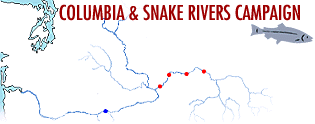
The Battle of the Dams
August 1998
Those who think some of our rivers are a dammed shame argue for the structures to come down.
Welcome to the contentious new world of dam removal. As development of natural resources is weighed against environmental protection, dams can no longer be taken for granted. North Carolina, Vermont and Wisconsin already have pulled down a number. But a complex national debate about safety, economic and environmental issues goes on. One-quarter of the nation's dams are 50 years old, and many need repair. Dams have contributed to the extinction of 106 native salmon and trout stocks in four Western states, despite hatching programs, fish passage, and barging. Yet, dams also provide nearly half of the nation's renewable energy — and their reservoirs are often popular recreation spots.
On 1 July 1999, the Edwards Dam was breached in Augusta, Maine, allowing the Kennebec River to run free for the first time in 162 years. This marks the first time The Federal Energy Regulatory Commission has denied an application to re-license an operating dam.
[ Links Related to this Story ]






[ Sierra Club Magazine May / June 1998 ]
Down Come the Dams
Rethinking progress and letting rivers run free
When the Sierra Club proposed draining Lake Powell last year, critics called it lunacy. How dare we suggest shutting down Glen Canyon Dam, one of the largest public-works projects in the United States, to let a river run wild? But the assumption that dams are permanent fixtures has already been breached: around the country they're falling like dominoes in the name of river restoration.
A month earlier, The Federal Energy Regulatory Commission (FERC) ordered the removal of the Edwards Dam on Maine's Kennebec River to restore fish habitats. That move will return salmon, shad, and other fish species to at least 15 miles of the Kennebec. The commission decided that the small amount of electricity generated by the dam did not justify the resulting environmental damage.
In November the Western Canal Dam on a tributary of California's Sacramento River was demolished to let threatened chinook salmon run free for the first time since the 1920s. Last year a local irrigation district voted to support the removal of the Savage Rapids Dam on Oregon's Rogue River, which would save $4 million in renovation costs and make life easier for the river's salmon and steelhead. The Newport No. 11 dam on the Clyde River in Vermont was removed in 1996, allowing salmon to return upstream for the first time in 40 years. And in this year's State of the Union address, President Clinton proposed spending $52 million to tear down the Glines Canyon Dam on the Elwha River in Washington state. That's in addition to an existing proposal to remove the Elwha Dam farther downstream in an effort to revive wild salmon runs.
Why all the sledgehammers? Some 550 dams will come up for relicensing by FERC in the next 15 years, and since 1986 the agency has been required to weigh a dam's impact on wildlife and recreation against its economic benefits. Not surprisingly, studies show that dams devastate fish runs and that the best way to resuscitate them is to remove the dams.
At the same time, energy deregulation and low electricity prices caused in part by a glut of natural gas, more efficient natural-gas turbines, and conservation have turned many dams into economic dinosaurs. In the Pacific Northwest, privately owned gas-fired turbines sell electricity at about the same price as dams operated by the federally subsidized Bonneville Power Administration.
Although large federal dams such as those on the Columbia aren't regulated by FERC, the utility of some of them is also being questioned. In the Columbia River basin, where salmon-recovery efforts have failed, policy makers are debating breaching dams on the Snake River for the first time. The river's salmon must contend with eight hydropower dams as they head downstream; along the way, up to 99 percent of smolts perish.
Lending credence to a proposal championed by the Sierra Club and other environmental groups, the editorial board of the Idaho Statesman in Boise concluded last year that the Northwest would realize a net economic benefit of $183 million a year by unplugging four dams on the lower Snake. But no one expects this effort to be as easy as toppling a 15-foot-high dam in Maine: while they're marginal contributors to the Northwest's power grid, the four Snake River dams enable barges to reach Lewiston, Idaho, 400 miles from the sea.
The U.S. Army Corps of Engineers and
National Marine Fisheries Service are expected to finish reviews of the proposal in late 1999.
Dams must now prove their worth against that of healthy rivers and fisheries—and they aren't measuring up. While building dams has always demonstrated our ability to control nature, dismantling them represents our capacity to live in harmony with it.—
[ The Yucatan's Flooded Basement ]
RELAX
Never Mind Its Savage Reputation,
The Piranha is a Pussycat--Most of the Time
Pacific Northwest
[ Architect Johnpaul Jones infuses a new Smithsonian museum with 'the way of the people' ]

